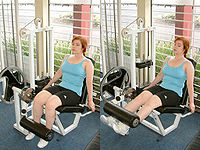
Photo from wikipedia
CONTEXT Within each hamstring muscle, there are segments with separate nerve innervation. However, a better understanding of activation levels within these regions during resistance exercise could lead to region-specific training… Click to show full abstract
CONTEXT Within each hamstring muscle, there are segments with separate nerve innervation. However, a better understanding of activation levels within these regions during resistance exercise could lead to region-specific training for improved performance and injury prevention. OBJECTIVE To compare muscle activation levels within regions of the hamstrings during various resistance exercises. DESIGN Within-subjects repeated measures. SETTING Biomechanics laboratory. PARTICIPANTS Eighteen young adult females with previous competitive sport participation and resistance training experience. INTERVENTION One set of 3 repetitions with an 8RM load on the bilateral squat, modified single-leg squat, stiff-legged dead lift, and leg curl (LC). MAIN OUTCOME MEASURES Normalized surface electromyography of 4 hamstring regions (proximal-medial, proximal-lateral, distal-medial, and distal-lateral). RESULTS For LC only, electromyography measures for the proximal-lateral location were significantly lower than for the distal-lateral, t18 = 5.6, P < .001, and proximal-medial, t18 = 2.4, P = .01 locations for concentric contractions. Similar results were observed for eccentric contractions. No other exercises revealed regional activation differences. When comparing the pooled proximal (medial and lateral) region across exercises, the LC demonstrated significantly greater activation than the modified single-leg squat, t18 = 5.20, P < .001, stiff-legged dead lift, t18 = 7.311, P < .001, and bilateral squat, F3,54 = 49.8, P < .001. Similar significantly greater levels were also found during the LC for the pooled distal, medial, and lateral regions. In addition, the modified single-leg squat electromyography was significantly greater at all regions in comparison with the stiff-legged dead lift and bilateral squat. CONCLUSIONS The data did not reveal consistent regional differences within the different exercises included in this study. However, the data indicate that the LC produces the highest hamstring activation in all regions across exercises. Inclusion of single-joint knee-flexion exercises would appear to be most beneficial for hamstrings development in a resistance-training program.
Journal Title: Journal of sport rehabilitation
Year Published: 2019
Link to full text (if available)
Share on Social Media: Sign Up to like & get
recommendations!